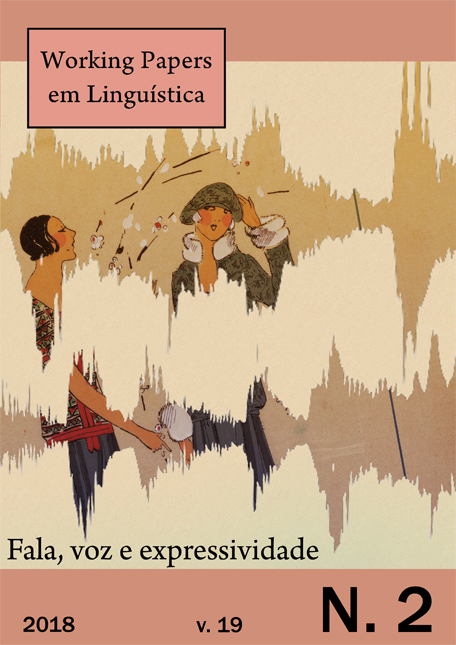Vocal aspect of social laughter during virtual interaction
DOI:
https://doi.org/10.5007/1984-8420.2018v19n2p54Abstract
The current paper focuses on the various types of laughter recorded during real social interactions in a virtual immersive environment. With this experiment, we investigate whether human beings are able to discriminate social from spontaneous laughter on the basis of auditory or audiovisual laughs presented outside any context. Towards this aim, we carried out two perceptual experiments proposing audio alone and audiovisual conditions, which were taken by French and Japanese native subjects. Each subject listened to (or looked at) 162 laughs and chose one response among three possibilities: social, spontaneous or unknown. The results of both experiments show that all participants are able to discriminate these two types of laughter with quite good confidence without contextual information: the correct identification rate for spontaneous laughter is about 70% with a similar amount for social laughter in audio alone and audiovisual conditions. We then extracted acoustic characteristics for each laugh in order to investigate potential differences between the two types of laughter. A multifactorial analysis showed that perceptual behaviors and some acoustic features (F0 and duration) are correlated. Especially, we observe a significant difference between social and spontaneous laughter through the features of total duration and voiced duration. Finally, we conducted a perceptual experiment on the subcategorization of social laughs based on three social factors: speaker’s physical state, speaker’s involvement and psychological distance. The results show that social laughter is characterized by similar contexts for both groups of listeners, except by Japanese subjects who regard the psychological distance between partners as distant.References
ANIKIN, A.; LIMA, C.F. Perceptual and acoustic differences between authentic and acted nonverbal emotional vocalizations. The Quarterly Journal of Experimental Psychology, p.1-21, 2017.
BACHOROWSKI, J.A.; SMOSKI, M. J.; OWREN, M. J. The acoustic features of human laughter. The Journal of the Acoustical Society of America, v. 110, n. 3, p. 1581-1597, 2001.
BERK, R. A. The active ingredients in humor: Psychophysiological benefits and risks for older adults. Educational Gerontology, v. 27, no 3-4, p. 323-339, 2001.
BOERSMA, P.; DAVID, W. Praat, a system for doing phonetics by computer [Computer program], Version 5.3.51, 2013.
BUTLER, B. Laughter The Best Medicine? Oregon Institute of Marine University of Oregon Biology, ed. Spring, v. 11, n. 1, p. 1, 2005.
CAMPBELL, N.; KASHIOKA, H.; OHARA, R. No laughing matter. In: Interspeech 2005, Lisbon, Portugal, 2005, p. 465-468.
ERICKSON, D.; MENEZES, C.; SAKAKIBARA, K. Are you laughing, smiling or crying? In: APSIPA ASC 2009: Asia-Pacific Signal and Information Processing Association, 2009 Annual Summit and Conference, Sapporo, Japan, 2009. p. 529-537.
FRÓIS, L., S.J. Traité sur les contradictions et différences de mœurs écrit par le R. P. Luís Fróis au Japon, l’an 1585, traduit du portugais, Paris, ed. Chandeigne,1998.
ISHI, C.; HATANO, H.; ISHIGURO, H. Audiovisual analysis of relations between laughter types and laughter motions. In : Proc. of the 8th international conference on Speech Prosody (Speech Prosody 2016). 2016. p. 806-810.
JACYKIEWICZ, T.; RINGEVAL, F. Automatic recognition of laughter using verbal and nonverbal acoustic features. 2014. Ph.D. dissertation - Department of Informatics, University of Fribourg, Switzerland, 2014.
JÜRGENS, R.; HAMMERSCHMIDT, K.; FISCHER, J. Authentic and play-acted vocal emotion expressions reveal acoustic differences. Frontiers in psychology, v. 2, p. 180, 2011.
KIPPER, S.; TODT, D. Variation of sound parameters affects the evaluation of human laughter. Behavior, v. 138, n. 9, p. 1161-1178, 2001.
LAVAN, N.; SCOTT, S.K.; MCGETTIGAN, C. Laugh like you mean it: Authenticity modulates acoustic, physiological and perceptual properties of laughter. Journal of Nonverbal Behavior, v. 40, n. 2, p. 133-149, 2016.
LIBERMAN, N.; TROPE, Y.; STEPHAN, E. Psychological distance. In: Social Psychology Handbook of basic principles. Guilford Press, v. 2, 2007. p. 353-381.
MATHÔT, S.; SCHREIJ, D.; THEEUWES, J. Opensesame: An opensource, graphical experiment builder for the social sciences. Behavior research methods, v. 44, n. 2, p. 314-324, 2012.
Downloads
Published
Issue
Section
License
Copyrights belong to the authors, who allow the Working Papers em Linguística journal to publish their work. Total or partial reproduction requires the Editorial Board's authorization. Names and adresses in this website are exclusively used for the journal's purposes and are not available for other purposes and/or third parties.
![]()
This publication is licensed under Creative Commons - Attribution-NonCommercial - 4.0 International.


